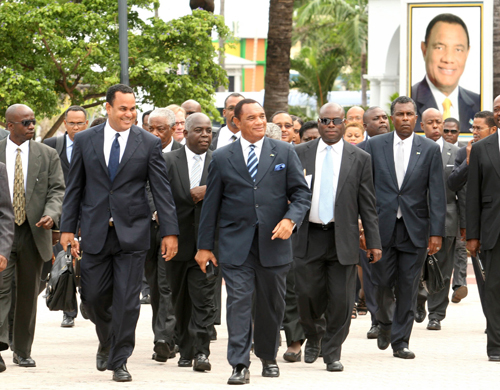IMF Executive Board Concludes 2015 Article IV Consultation with The Bahamas
Press Release No. 15/269 – June 10, 2015

BAHAMAS NOW MOVING FORWARD AND IS GETTING STRONGER ACCORDING TO IMF BOARD REPORT!
On June 8, 2015, the Executive Board of the International Monetary Fund (IMF) concluded the Article IV consultation with The Bahamas.1
Real GDP expanded by an estimated 1 percent in 2014 on the back of increased tourist arrivals, but growth remains well below pre-global crisis levels. Supported, in part, by rising US economic activity, air arrivals grew by almost 5 percent in 2014 and applied room rates improved by 7 percent. Domestic demand has been weighed down by the weak macroeconomic outlook, high household indebtedness, and high unemployment which stood at 15.7 percent in November 2014. Inflation rose to 2.2 percent in January 2015 (1.2 percent in December 2014), as the imposition of the value added tax (VAT) offset the effects of declining oil prices.
The fiscal deficit in FY2013/14 is estimated to have narrowed to 3.3 percent of GDP from 5.4 percent in FY2012/13. Revenue was lower-than-budgeted, but a substantial reduction in current spending resulted in an overall fiscal deficit below the budget target. The debt GDP ratio is estimated to have reached 61 percent in FY2013/14 from 56 percent in FY2012/13.The external current account continues to record sizable deficits, 22 percent of GDP in 2014, reflecting the large import component of the Baha Mar resort project. International reserves totaled US$839 million at end-March 2015, equivalent to 2.3 months of next year’s projected imports of goods and services. Nonperforming loans remain elevated at 16 percent of total loans at end-March 2015, and continues to constrain private sector credit growth. While domestic banks continue deleveraging, the banking sector remains well capitalized and liquid.
Growth is expected to strengthen over 2015–16 with the improvement in US activity and the opening of Baha Mar but significant structural impediments remain. Potential GDP growth is estimated at about 1½ percent over the medium term, insufficient to generate a significant reduction in the high unemployment rate. Absent structural reforms, including in the labor market and the energy sector, significantly higher growth than currently projected will be required to absorb new entrants to the labor force and reduce the unemployment rate to single digits over the medium term. The full opening of Baha Mar and two smaller projects, together with the strengthening US economy could represent a major boost to exports in the near-term. Beyond 2016, growth would taper off as US growth decelerates, and the base effects from the opening of Baha Mar fade. Inflation is expected to remain low, but VAT implementation early this year would add an estimated 2½ percentage points to the CPI. Over the medium term, the external current account deficit would return to single digits as construction-related outflows are anticipated to be replaced by a rise in travel services receipt. Risks to the outlook continue to be tilted to the downside, necessitating continued fiscal consolidation, and implementation of structural measures to strengthen competitiveness, raise potential growth and lower unemployment.
Executive Board Assessment2
Executive Directors noted that the economy is recovering but the outlook remains challenging. Despite the U.S. recovery and the imminent opening of the Baha Mar resort, growth is expected to remain below pre-global crisis levels, and the current account deficit remains elevated. Against this backdrop, Directors called for structural reforms to strengthen competitiveness, raise potential growth, and lower unemployment; and for continued efforts to strengthen the fiscal position.
Directors underscored the importance of finalizing and implementing the National Development Program (NDP) to accelerate medium-to-long-term economic and social development, including through diversification of the economy. Active labor market policies could help foster job creation and, in this context, Directors urged the authorities to build on existing training programs and placement services, while easing restrictions on labor mobility. Over the medium term, enhancing the efficiency of labor market regulations and institutions and greater investment in human capital will be essential to increasing productivity and competitiveness. Directors also stressed the importance of stepping up reforms of the state-owned enterprises, in particular in the energy sector.
Directors commended the authorities for the substantial progress on fiscal consolidation, and successful introduction of the VAT. They called for steadfast implementation of the planned fiscal consolidation in order to rebuild buffers and place public debt on a declining path. In this regard, they stressed the need for continued revenue reforms, including strengthening tax administration. They also recommended rationalization of current expenditures in the context of a medium–term budget framework.
Directors generally agreed that the exchange rate peg has continued to serve The Bahamas well. To support the peg going forward, they stressed the importance of structural reforms to improve competitiveness, noting that this would also avoid placing an excessive burden on fiscal policy.
Directors welcomed continued progress in financial sector reforms, including the planned introduction of a new credit bureau. They noted that the financial sector remains well capitalized and liquid, and agreed that efforts to further strengthen financial sector regulation and supervision should continue. Directors recommended that the authorities adopt policies that will address persistently high non-performing loans to allow the banking system to play a more effective role in supporting growth.







